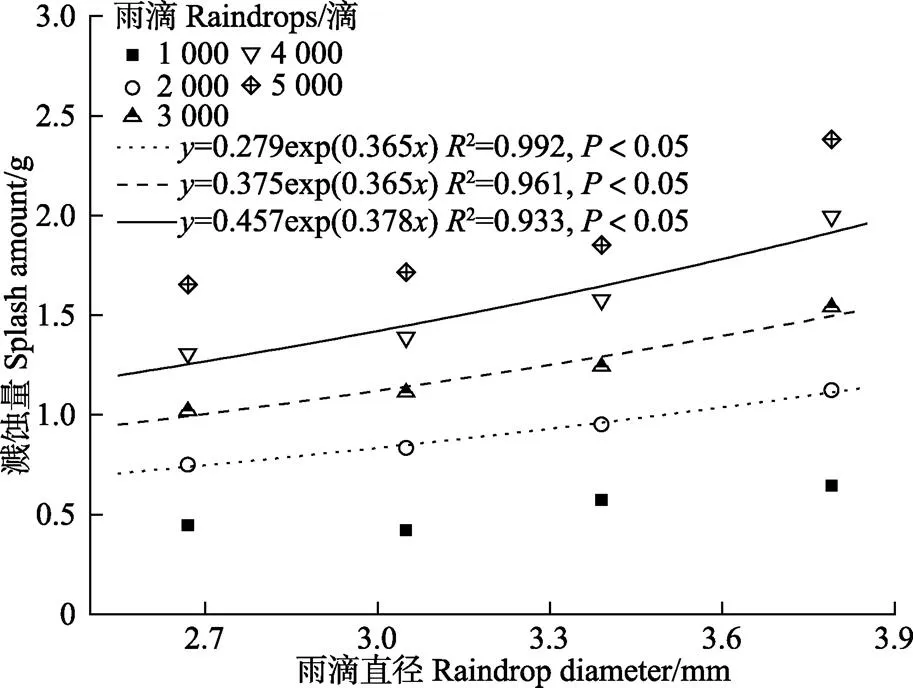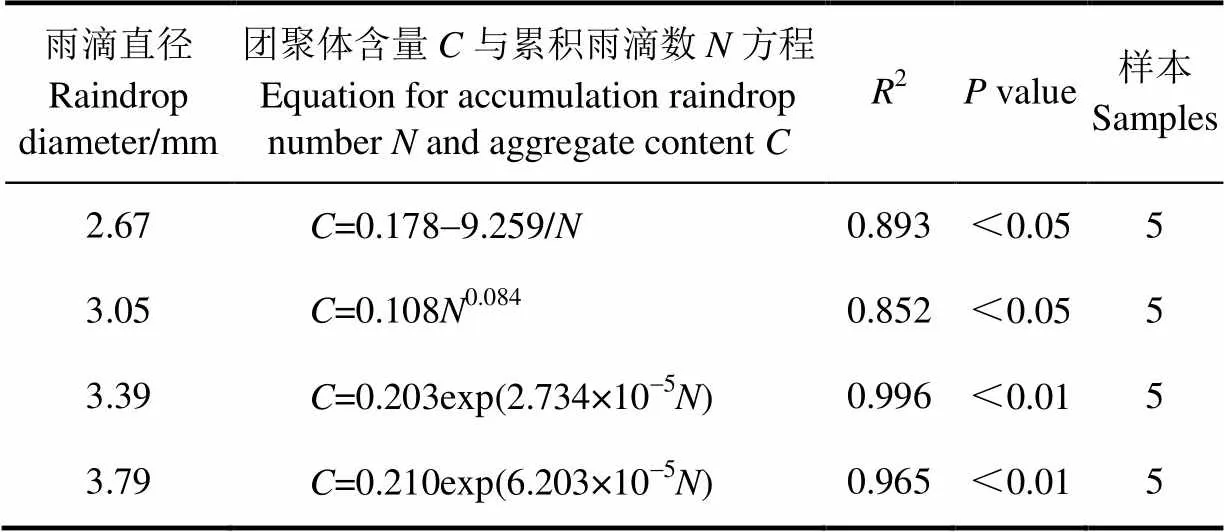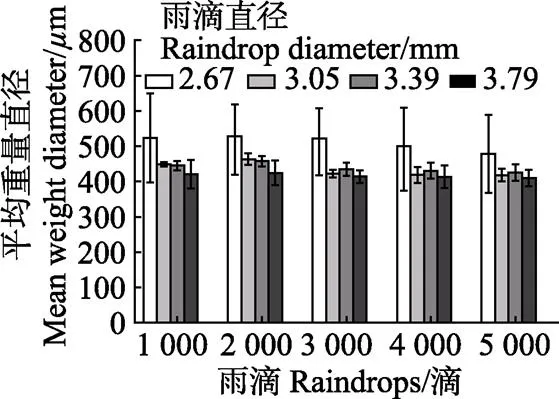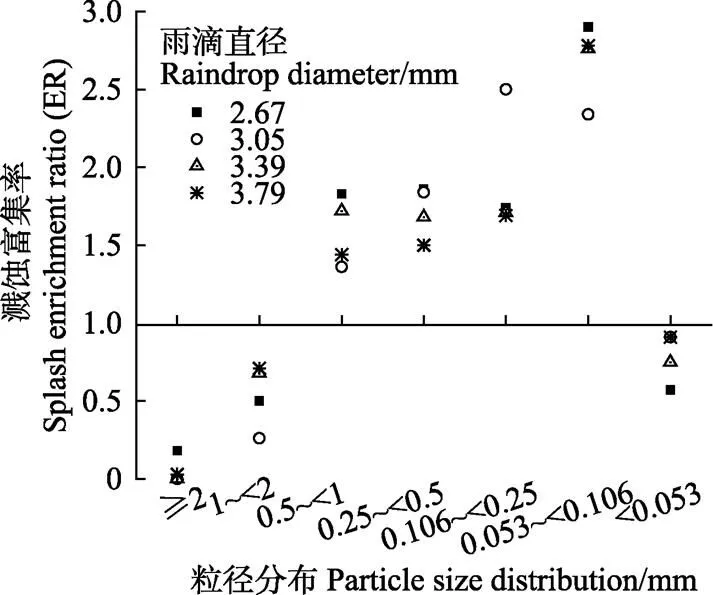雨滴击溅对耕作层土壤团聚体粒径分布的影响
2017-03-04李光录郑腾辉李柏桥
付 玉,李光录,2※,郑腾辉,李柏桥,张 腾
雨滴击溅对耕作层土壤团聚体粒径分布的影响
付 玉1,李光录1,2※,郑腾辉1,李柏桥3,张 腾4
(1. 西北农林科技大学水土保持研究所,杨凌 712100;2. 西北农林科技大学资源环境学院,杨凌 712100; 3. 绵阳市农业科学研究院,绵阳 621023;4. 中国电建集团华东勘测设计研究院有限公司,杭州 311122)
为研究不同雨滴直径的降雨对耕作层团聚体的破碎及其粒径分布特征的影响,该文选取4个雨滴直径(2.67~3.79 mm)对耕层土壤(0~20 cm)团聚体进行雨滴击溅试验,每次试验各滴5 000滴,每1 000滴收集1次溅蚀团聚体。结果表明:1)所有收集次序中雨滴直径3.79 mm溅蚀量最大,累积雨滴数为2 000、3 000和4 000时,溅蚀量与雨滴直径均呈显著的指数函数关系。2)各雨滴直径的溅蚀量随粒径减小呈增大-减小-增大趋势,>2 mm粒径的溅蚀量几乎为0,<0.053 mm粒径的溅蚀量随雨滴直径增大而增大。3)相同雨滴直径不同累积雨滴数之间平均重量直径值差异不显著,相同累积雨滴数不同雨滴直径之间平均重量直径值差异不显著(<0.05)。4)不同雨滴直径溅蚀团聚体富集率随粒径变化一致,>1 mm粒径溅蚀量团聚体富集率值接近0,0.053~1 mm粒径团聚体富集,>1 mm粒径团聚体主要破碎成0.053~1 mm粒径团聚体,且粒级越小,富集率越高。研究可为黄土高原地区水土保持提供理论依据。
侵蚀;团聚体;粒径;雨滴击溅;富集率;黄土高原
0 引 言
土壤团聚体是矿物颗粒和有机物通过胶体的凝聚、粘结和胶结作用及有机-矿质胶体的复合作用,并在生物参与下形成的不同粒径大小的多孔结构,也是土壤结构的基本单元,被认为是调节土壤生物、物理和化学特性的重要因素[1-3]。雨滴击溅导致土壤表层团聚体分散破碎,是土壤侵蚀发生的初级阶段[4-5],雨滴打击使团聚体崩解、分散,为后续径流搬运提供了丰富的松散颗粒[6-9]。同时,土粒迁移造成土壤表层孔隙减少或堵塞,形成“板结”使土壤渗透性下降。
击溅侵蚀是降雨特性和土壤特性相互作用的结果,任何降雨所引发的溅蚀都受这两方面的制约。降雨特性包括降雨强度、雨滴动能及降雨历时等[10]。降雨动能是决定土壤颗粒分散和搬运的重要因素[11]。Rose[12]和Parsons等[13]研究表明溅蚀量与降雨动能呈正相关关系。Salles等[14]指出雨滴直径控制着雨滴能量,是土壤击溅侵蚀的重要参数,降雨历时不同,团聚体破坏程度也不同。Woodbarn[15]发现单位时间溅蚀率随降雨历时的增加呈指数递减,这主要是由于粗颗粒增加了地表粗糙度从而增加了雨滴在土壤颗粒上的能量消耗。Yang等[16]研究表明60 mm/h雨强条件下,1.5 mm降雨量是团聚体破碎的主要阶段。土壤种类不同,其黏粒、有机质含量以及其他引起土壤黏结和胶结作用的物质也存在差异,土壤团粒黏结结构的增加能有效减少雨滴击溅下土粒的分散破坏。Epstein等[17]指出相同降雨条件下,粘粒含量最低的砂土溅蚀量最多。范荣生等[18-19]认为土壤颗粒级配状况决定溅蚀特征,并且认为细砂最易被雨滴击溅,而粗砂则相反。此外,降雨对坡面侵蚀和侵蚀团聚体粒径分布特征的影响也有较为广泛的研究[20-25]。土壤团聚体的粒径分布及稳定性不仅影响土壤的孔隙分布,还决定着孔隙径级的分布和形态特征[26]。
黄土高原是世界上水土流失最严重地区之一,雨滴击溅使团聚体破碎迁移、土壤结构破坏、表层孔隙阻塞和耕作层土壤板结。此外,土壤团聚体破坏使耕层土壤保水保肥性能下降,土壤结构变差,直接制约着黄土高原地区的农业发展。击溅实际是由众多雨滴接力作用的总效果[27],虽然单个雨滴的能量较小,但累积雨滴降雨对土壤团聚体破坏的影响不容忽视,并且目前的研究主要集中在击溅侵蚀的影响因素方面,而雨滴直径作为降雨特性的研究较少。本文以黄土高原典型地带性耕作层土壤为对象,定量研究不同降雨条件下溅蚀团聚体粒级分布特征及其数量变化,以深入揭示降雨侵蚀机理,为黄土高原地区水土保持提供理论依据。
1 材料与方法
1.1 采样点及土样理化性质
试验地位于陕西省杨凌区黎张沟村(108°03′29.18″E,34°18′24.30″N),海拔532 m,属暖温带半湿润半干旱区。年均气温13 ℃,年平均降雨量550~650 mm,主要集中在7、8、9月,土壤为黄土母质发育的塿土,主要作物为玉米(L)和冬小麦()。采样前先去除表层枯枝落叶,采用对角线法用环刀(直径10 cm,高5 cm)取表层土(0~20 cm),共采集15个环刀样品和1 000 g散土,其中3个环刀用来测定土壤容重和含水率,其余12个环刀样品用于雨滴击溅试验。1 000 g散土自然风干后,用于基本理化性质分析,容重、含水率、有机质、全氮、全磷和机械组成分别采用环刀法、烘干法、重铬酸钾外加热法、HClO4-H2SO4法和马尔文激光粒度仪法[28-29]。样地土壤容重(1.37±0.13)g/cm3、有机质1.46%±0.03%、全氮(1.04±0.02)g/kg、全磷(0.62± 0.02)g/kg,砂粒(2~0.02 mm)、粉粒(0.002~< 0.02 mm)、黏粒(<0.002 mm)各占33.26%±0.05%、44.07%±0.03%、22.67%±0.02%。
1.2 试验设计与分析
试验采用针头式模拟降雨装置,由雨滴发生装置、收集装置和水箱3部分组成。图1为击溅装置图。雨滴发生装置为下滴式,其形状为上部开口的圆柱体(直径10 cm,高10 cm),圆柱体底部中心布设医用针头1个,当选用的针头型号不同时,产生的雨滴直径不同。测试区为直径10 cm,高5 cm环刀,环刀上下两端不封闭。收集装置是一个反向去顶的锥形击溅盘,收集装置与测试区之间有个斜面,在斜面的最底部有排水孔。模拟降雨时,击溅出测试区所有土壤都会被收集。在整个试验装置外围布设遮挡塑料薄膜,以防止雨滴降落过程中受到横向气流的扰动。

图1 击溅装置图
试验选用4个雨滴直径,采用人工计时的方法,当第1滴雨滴从针头滴出时,开始计数,每次试验各滴5 000滴,每1 000滴收集1次溅蚀团聚体,为保护团聚体结构,减少溅蚀盘清洗过程对团聚体的破坏,使用酒精将其通过排水孔洗出[30],收集次序为Ⅰ、Ⅱ、Ⅲ、Ⅳ、Ⅴ。各次试验重复3次。用团聚体分析仪(浙江省上虞市舜龙实验仪器厂TTF-100)将收集的团聚体湿筛分为≥2、1~<2、0.5~<1、0.25~<0.5、0.106~<0.25、0.053~<0.106、<0.053 mm共7个等级,然后用蒸馏水分别洗到铝盒中并标记,在105 ℃下烘干24 h后称质量。每次试验结束后均将击溅盘清洗干净,准备下次试验。模拟降雨雨滴主要参数见表1。选取的雨滴直径为2.67、3.05、3.39和3.79 mm,符合自然降雨雨滴直径范围,其对应的降雨强度5.76、21.00、68.61和127.44 mm/h分别对应小雨、中雨、暴雨和大暴雨,并且终点速度和降雨动能均符合黄土高原的降雨特征[31]。

表1 模拟降雨雨滴主要参数
1.3 数据分析
团聚体富集率(enrichment ratio,ER)是反映溅蚀对土壤团聚体分选作用的重要指标。对于每个粒级,ER由原团聚体和溅蚀团聚体质量百分数计算得来。当ER>1表明颗粒富集,ER<1时表明颗粒减少,ER计算如下:
ER=P/P(1)
式中P和P分别为溅蚀前后土壤团聚体中某一粒级的含量。
土壤团聚体平均重量直径(mean weight diameter,MWD)可作为团聚体分布情况评价指标之一[32]。MWD越大,说明破碎后大粒径团聚体含量越多。本研究使用Le Bissonnais法[28]计算MWD:
式中r为每个网筛的孔隙大小,mm;m为在级筛中团聚体含量。
采用Excel 2003和SPSS 16.0进行数据处理和相关及回归分析,差异显著性检验采用双尾最小显著差异法多重比较(least significance difference test,LSD)确定,显著性水平0.05,采用Origin 8.5进行数据绘图。
2 结果与分析
2.1 雨滴直径对团聚体溅蚀量的影响
不同雨滴直径各收集次序团聚体溅蚀量统计结果如表2所示。雨滴直径2.67 mm各收集次序之间差异不显著(>0.05),雨滴直径3.05 mm收集次序Ⅰ和Ⅱ溅蚀量之间差异不显著(>0.05),与其余次序溅蚀量之间差异显著(<0.05)。对于雨滴直径3.39和3.79 mm,Ⅱ~Ⅴ溅蚀量之间基本不显著(>0.05),与Ⅰ相比显著减小了33.90%~52.09%和25.68%~39.79%。这可能是由于随着雨滴直径增大,雨滴在同一处连续击打后形成一定深度的溅蚀坑,阻碍被分散的土粒溅出。

表2 雨滴直径对溅蚀量的影响
注:不同大写字母表示相同次序下雨滴直径间差异显著(<0.05);不同小写字母表示相同雨滴直径下不同次序间差异显著(<0.05)。
Note: Different capital letters indicate significant difference (<0.05) among raindrop diameters for the same order(<0.05); Different small letters indicate significant difference (<0.05) among order at the same raindrop diameter.
各次序(I~Ⅴ)中雨滴直径3.79 mm溅蚀量最大,分别是其他雨滴直径溅蚀量的1.11~1.53倍、1.16~1.58倍、1.43~1.58倍、1.24~1.65倍和1.12~1.41倍。图2表示累积雨滴数溅蚀量与雨滴直径的关系,累积雨滴数为2 000、3 000和4 000时,溅蚀量随雨滴直径增大均呈显著递增的指数函数关系(R=0.933~0.992,<0.05)。雨滴直径通过影响降雨动能进而影响降雨侵蚀力,最终会影响土壤溅蚀量[33]。这表明雨滴直径可以作为雨滴击溅过程中有效影响溅蚀的降雨特征参数之一。

图2 不同累积雨滴数条件下溅蚀量与雨滴直径的关系
2.2 团聚体粒径分布特征
图3表示不同雨滴直径击溅下累积雨滴数5 000滴产生溅蚀量的粒径分布。通过对溅蚀团聚体的粒径分析,能有效地阐明团聚体在不同雨滴直径降雨条件下的溅蚀特征。由图3可知,4个雨滴直径的溅蚀量随粒径减小呈增大-减小-增大的“N”型变化趋势。当雨滴直径为2.67和3.39 mm时,溅蚀团聚体以0.5~1 mm粒径为主,质量为0.423和0.435 g;雨滴直径为3.05和3.79 mm时, <0.053 mm团聚体质量分数最多,分别占其雨滴直径溅蚀量的22.26%和28.03%。雨滴直径最大时,除了粒径 ≥2 mm,其余各粒级团聚体含量均高于其他雨滴直径(图3),这是由于雨滴直径越大,其动能越大,产生的溅蚀团聚体越多[34]。对于所有降雨试验,≥2 mm的溅蚀量几乎为0,是因为雨滴打击土粒的能量较低,且大粒径团聚体由于本身质量较大,所以受击溅影响很小。雨滴直径越大即雨强越大,<0.053 mm溅蚀量越多。Sajjadi等[35]研究在57和80 mm/h 2种不同雨强下雨滴击溅试验,结果表明较大的雨强下,<0.043 mm团聚体溅蚀的数量更多。这说明雨滴直径越大,降雨侵蚀力越大,大团聚体破碎程度越高,产生更多的细颗粒。

图3 5 000滴不同雨滴直径溅蚀团聚体粒径分布
筛分溅蚀团聚体得到其粒径分布如表3所示。

表3 不同雨滴直径累积雨滴数的溅蚀团聚体的粒径分布
表3表明,>1mm团聚体随积累雨滴的增加变化不明显,而0.5~<1 mm随之呈减少趋势。雨滴直径为 2.67 mm时,0.25~<0.5 mm团聚体含量随累积雨滴数增大而增大,当雨滴直径>2.67 mm时,总体呈相反趋势。<0.25 mm的3个粒级团聚体含量随累积雨滴数的增大呈波动式上升,这表明>0.25 mm团聚体逐步破碎成< 0.25 mm的微团聚体,Legout等[5]研究认为大团聚体(>0.25 mm)是由微团聚体(<0.25 mm)粘结成,在破坏时大团聚体逐步分解成微团聚体,这与本研究结果一致。对相同雨滴直径<0.053 mm团聚体含量与累积雨滴数进行回归分析(表4),表明对于雨滴直径2.67和3.05 mm,<0.053 mm团聚体含量随累积雨滴数的增加分别呈显著递增关系;当雨滴直径>3.05 mm,<0.053 mm团聚体含量随累积雨滴数的增加皆呈极显著递增指数函数关系。由表3可知,累积雨滴数相同时,≥2和1~<2 mm团聚体质量分数最低,仅为0~4.69%和6.83%~12.84%;>0.5~1和0.25~<0.5 mm团聚体所占比例最大,是溅蚀总量的37.01%~48.73%,且随着雨滴直径增加,比例逐渐降低;0.106~<0.25 mm团聚体含量随雨滴直径增大呈大-小-大的“N”型变化趋势;0.053~<0.106 mm团聚体随雨滴直径增加变化不明显<0.053 mm团聚体含量随雨滴直径增大总体呈增大趋势,极差为5.23%~10.45%。

表4 不同雨滴直径条件下粒径<0.053 mm团聚体含量与累积雨滴数的关系
2.3 溅蚀团聚体特征参数与雨滴直径的关系
图4为不同雨滴直径溅蚀团聚体MWD的变化。相同雨滴直径不同累积雨滴数之间MWD值差异不显著,相同累积雨滴数不同雨滴直径之间MWD值差异不显著(>0.05)。这说明在本试验模拟降雨条件下,累积雨滴数降雨对土壤团聚体MWD值影响不大。

图4 不同累积雨滴数溅蚀团聚体平均重量直径
溅蚀团聚体7个粒径级别ER的变化如图5所示,总体来说,不同雨滴直径溅蚀团聚体ER值随粒径变化是一致的,除了<0.053 mm团聚体,其余粒径团聚体ER值皆随粒径减小逐渐增大,这一结论与Legout等[36]相反,可能是由于本研究所选取的土是塿土,黏结性较高,且本试验采用的是单雨滴,单个雨滴的能量较小且在一处连续击溅,大颗粒易破碎成较小粒径的团聚体。

图5 不同雨滴直径7种粒径的溅蚀富集率
通过所有土壤样品降雨试验,结果表明,>1 mm溅蚀量ER值接近0,这与Ma等[37]的研究一致,其认为在雨强为58.1 mm/h条件下,2~5和1~2 mm富集率值接近0。这表明在本研究试验条件下,击溅侵蚀能力不足以搬运这些粒径的团聚体。研究表明,在雨强及降雨动能不变时,溅蚀过程中雨滴对土壤颗粒具有分选特性,而这一特性主要取决于表土颗粒粒径分布及表土结构[36]。Puget等[38]提出土壤团聚体分层模型,即大团聚体由微团聚体粘结而成。也有研究[39]在此基础上假设土壤耕作层中大团聚体在外界条件破坏下逐步分离微团聚体(<0.25 mm)。在本研究中,对于所有雨滴直径,>1和<0.053 mm团聚体较击溅前减少,其余粒径团聚体ER>1,说明0.053~1 mm团聚体富集,且粒级越小,富集率越高。
3 结论与讨论
1)所有收集次序中雨滴直径3.79 mm溅蚀量最大,累积雨滴数为2 000、3 000和4 000时,溅蚀量随雨滴直径增大均呈显著递增的指数函数关系(R=0.933~0.992,<0.05)。各雨滴直径的溅蚀量随粒径的减小呈增大-减小-增大趋势,0.053~<0.106 mm团聚体随雨滴直径增加的变化不明显。≥2 mm溅蚀量几乎为0,<0.053 mm溅蚀量随雨滴直径增大而增大,雨滴直径越大,降雨侵蚀力越大,大团聚体破碎程度越高,产生更多的细颗粒。
2)相同累积雨滴数不同雨滴直径之间MWD值差异不显著(>0.05),说明累积雨滴数降雨对MWD值影响不大。
3)不同雨滴直径溅蚀团聚体ER值随粒径变化一 致,>1 mm溅蚀量ER值接近0,粒径1~0.053 mm团聚体富集,>1 mm团聚体主要破碎成1~0.053 mm团聚体,且粒级越小,富集率越高。
本文通过模拟降雨的方法,研究了雨滴直径(2.67~3.79 mm)对耕层土壤团聚体破碎及其粒径分布特征的影响,揭示了不同直径雨滴击溅下团聚体粒径分布的数量关系,对认识和指导黄土高原地区农业发展有重要科学意义。限于模拟降雨选择的参数有限,所产生的样本数量较少,并且本研究仅考虑降雨因子对耕层团聚体的影响,今后的研究可以分析比较室内模拟降雨与自然降雨条件下土壤团聚体破坏程度的差异,也可以从坡度,耕作方式,作物类型等方面进行扩展研究。
[1] Jasinska E, Wetzel H, Baumgartl T, et al. Heterogeneity of physico-chemical properties in structured soils and its consequences[J]. Pedosphere, 2006, 16(3): 284-296.
[2] Huang Li, Wang Chunyan, Tan Wenfang, et al. Distribution of organic matter in aggregates of eroded Ultisols Central China[J]. Soil Tillage Research, 2010, 108 (1): 59-67.
[3] Falsone G, Bonifacio E, Zanini E. Structure development in aggregates of poorly developed soils through the analysis of the pore system[J]. Catena, 2012, 95(1): 169-176.
[4] Shainber G I, Levy G J, Rengasamy P, et al. Aggregate stability and seal formation as affected by drops impact energy and soil amendments[J]. Soil Science, 1992, 154(2): 113-119.
[5] Legout C, Leguédois S, Le Bissonnais Y. Aggregate breakdown dynamics under rainfall compared with aggregate stability measurements[J]. European Journal of Soil Science, 2005b, 56(2): 225-38.
[6] Ramos M C, Nacci S, Pla I. Effect of raindrop impact and its relationship with aggregate stability to different disaggregation forces[J]. Catena, 2003, 53(4): 365-376.
[7] Salles C, Poeson J, Govers G. Statistical and physical analysis of soil detachment by rainfall impact:Rain erosivity indices and threshold energy[J]. Water Resource Research, 2000, 36(9): 2721-2729.
[8] 李光录,吴发启,庞小明,等. 泥沙输移与坡面降雨和径流能量的关系[J]. 水科学进展,2008,19(6):868-874. Li Guanglu, Wu Faqi, Pang Xiaoming, et al. Relationship between sediment transport with surface rainfall and runoff energies on sloping[J]. Advances in Water Science, 2008, 19(6): 868-874. (in Chinese with English abstract)
[9] 马仁明,蔡崇法,李朝霞,等. 前期土壤含水率对红壤团聚体稳定性及溅蚀的影响[J]. 农业工程学报,2014,30(3):95-103. Ma Renming, Cai Chongfa, Li Zhaoxiao, et al. Effect of antecedent soil moisture on aggregate stability and splash erosion of krasnozem[J]. Transactions of the Chinese Society of Agricultural Engineering (Transactions of the CSAE), 2014, 30(3): 95-103. (in Chinese with English abstract)
[10] Sutherland R A, Wan Y, Ziegler A D, et al. Splash and wash dynamics: an experimental investigation using an Oxisol[J]. Geoderma, 1996, 69(1): 85-103.
[11] Martinez-Mena M, Castillo V, Albaladejo J. Relations between interrill erosion processes and sediment particle size distribution in a semiarid Mediterranean area of SE of Spain[J]. Geomorphology, 2002, 45(3): 261-275.
[12] Rose C W. Soil detachment caused by rainfall[J]. Soil Science, 1960, 89(1): 28-35.
[13] Parsons A J, Abrahams A D, Wainwright J. Rainsplash and erosion rates in an interrill area on semi-arid grassland southern Arizona[J]. Catena, 1994, 22(3): 215-226.
[14] Salles C, Poeson J, Govers G. Statistical and physical analysis of soil detachment by rainfall impact:Rain erosivity indices and threshold energy[J]. Water Resource Research, 2000, 36(9): 2721-2729.
[15] Woodbarn R. The effect of structural condition on soil detachment by raindrop action[J]. Agricultural Engineering, 1958, 29: 154-158.
[16] Yang Wei, Li Zhaoxia, Cai Chongfa, et al. Tensile strength and friability of Ultisols in sub-tropical China and effects on aggregate breakdown under simulated rainfall[J]. Soil Science, 2012, 177(6): 377-384.
[17] Epstein E, Grant W J. Soil losses and crust formation as related to some soil physical properties[J]. Soil Science Society of America Proceedings, 1967, 31(4): 547-550.
[18] 范荣生,李占斌. 坡地降雨溅蚀及输沙模型[J]. 水利学报,1993(6):24-29. Fan Rongsheng, Li Zhanbin. Slope rainfall splash erosion and sediment tranport model[J]. Journal of Hydraulic Engineering, 1993(6): 24-29. (in Chinese with English abstract)
[19] 程勤娟,蔡强国,胡霞. 不同粒径黄绵土的溅蚀规律及表土结皮发育研究[J]. 土壤学报,2007,44(3):392-396. Cheng Qinjuan, Cai Qianghuo, Hu Xia. Rain splash erosion and soil crust development of Loess soil didderent in particle-size[J]. Acta Pedologica Sinica, 2007, 44(3): 392-396. (in Chinese with English abstract)
[20] Barthès B, Roose E. Aggregate stability as an indicator of soil susceptibility to runoff and erosion; validation at several levels[J]. Catena, 2002, 47(2): 133-149.
[21] Lado M, Ben-Hur M, Shainberg I. Soil wetting and texture effects on aggregate stability, seal formation, and erosion[J]. Soil Science Society of American Journal, 2004, 68(6): 1992-1999.
[22] Abu-Hamdeh N H, Abo-Qudais S A, Othman A M. Effect of soil aggregate size on infiltration and erosion characteristics[J]. European Journal of Soil Science, 2006, 57(5): 609-616.
[23] Furbish D J, Hamner K K, Schmeeckle M, et al. Rain splash of dry sand revealed by high-speed imaging and sticky paper splash targets[J]. Journal of Geophysical Research, 2007, 112(F1): 1-19.
[24] Warrington D N, Mamedov A I, Bhardwag A K, et al. Primary particle size distribution of eroded material affected by degree of aggregate slaking and seal development[J]. European Journal of Soil Science, 2009, 60(1): 84-93.
[25] Yan Fengling, Shi Zhihua, Cai Chongfa, et al. Wetting rate and clay content effects on interrill erosion in Ultisols of southeastern China[J]. Pedosphere, 2010, 20(1): 129-136.
[26] Biox-Fayos C, Calvo-Cases A, Imeson A C, et al. Influence of soil properties on the aggregation of some Mediterranean soils and the use of aggregate size and stability as land degradation indicators[J]. Catena, 2001, 44(1): 47-67.
[27] 赵晓光,吴发启. 单雨滴击溅规律及其对溅蚀土粒的分选作用[J]. 水土保持学报,2001,15(1):43-45. Zhao Xiaoguang, Wu Faqi. Single raindrop splash law and its selection role on soil particles splashed[J]. Journal of Soil and Water Conservation, 2001, 15(1): 43-45. (in Chinese with English abstract)
[28] 刘光崧. 土壤理化分析与剖面描述[M]. 北京:中国标准出版社,1996.
[29] Wang Bing, Zhang Guanghui, Shi Yangyang, et al. Soil detachment by overland flow under different vegetation restoration models in the Loess Plateau of China[J]. Catena, 2014b, 116(5): 51-59.
[30] Le Bissonnais Y, Arrouays D. Aggregate stability and assessment of soil crustability and erodibility: I. Theory and methodology[J]. European Journal of Soil Science, 1996, 47(4): 425-437.
[31] 焦菊英,王万中,郝小品. 黄土高原不同类型暴雨的降水侵蚀特征[J]. 干旱区资源与环境,1999,13(1):34-42. Jiao Juying, Wang Wanzhong, He Xiaopin. Precipitation and erosion characteristics of rain-storm in different pattern on Loess Plateau[J]. Journal of Arid Land Resources and Environment, 1999, 13(1):34-42. (in Chinese with English abstract)
[32] 周虎,吕贻忠,杨志臣,等. 保护性耕作对华北平原土壤团聚体特征的影响[J]. 中国农业科学,2007,40(9):1973-1979. Zhou Hu, Lü Yizhong, Yang Zhichen, et al. Effects of conservation tillage on soil aggregates in huabei plain, China[J]. Scientia Agricultura Sinica, 2007, 40(9): 1973-1979. (in Chinese with English abstract)
[33] 陈安强,张丹,熊东红,等. 元谋干热河谷坡面表层土壤力学特性对其抗冲性的影响[J]. 农业工程学报,2012,28(5):108-113. Chen Anqiang, Zhang Dan, Xiong Donghong, et al. Effects of mechanical properties of surface soil on soil anti-scourability in Yuanmou dry-hot valley[J]. Scientia Agricultura Sinica, 2012, 28(5):108-113. (in Chinese with English abstract)
[34] 程金花,秦越,张洪江,等. 华北土石山区模拟降雨下土壤溅蚀研究[J]. 农业机械学报,2015,46(2):153-161. Cheng Jinhua, Qin Yue, Zhang Hongjiang, et al. Splash erosion under artificial rainfall in Rocky mountain area of northern China[J]. Transactions of the Chinese Society for Agricultural Machinery, 2015, 46(2): 153-161. (in Chinese with English abstract)
[35] Sajjadi A S, Mahmoodabadi M. Aggregate breakdown and surface seal development influenced by rain intensity, slope gradient and soil particle size[J]. Solid Earth, 2015, 6(1): 311-321.
[36] Legout C, Leguedois S, Le Bissonnais Y, et al. Splash distance and size distributions for various soils[J]. Geoderma, 2005a, 124(3): 279-292.
[37] Ma Renming, Li Zhaoxia, Cai Chongfa, et al. The dynamic response of splash erosion to aggregate mechanical breakdown through rainfall simulation events in Ultisols (subtropical China)[J]. Catena, 2014, 121(7): 279-287.
[38] Puget P, Chenu C, Balesdent J. Dynamics of soil organic matter associated with particle-size fractions of water-stable aggregates[J]. European Journal of Soil Science, 2000, 51(4): 595-605.
[39] Plante A F, Feng Y, Mcgill W B. A modelling approach to quantifying soil macroaggregate dynamics[J]. Canadian Journal of Soil Science, 2002, 82(2): 181-190.
Effects of raindrop splash on aggregate particle size distribution of soil plough layer
Fu Yu1, Li Guanglu1,2※, Zheng Tenghui1, Li Baiqiao3, Zhang Teng4
(1.712100;2.712100;3.621023,4.311122)
Splash erosion, which is a main dynamic for the detachment and transport of soil aggregates, is the initial stage of soil water erosion. Soil aggregate is a crucial indicator determining the plough layer soil fertility. Destruction of the plough layer aggregate has a negative effect on the content of soil available water and soil fertility, destroying the soil structure and restricting agricultural development of the Loess Plateau. To determine the effect of raindrop diameters on the breakdown of soil aggregates of plough layer and the characteristic of splashed fragment size distribution in the process of raindrop splash erosion, an artificially simulated raindrop splash experiment was conducted with 4 raindrop diameters (2.67, 3.05, 3.39 and 3.79 mm) using a self-designed simulated device that had a circular room with a 10-cm diameter for placing soil samples. The soil sample was collected from the soil plough layer (0-20 cm) with a steel ring (10 cm in diameter).The sampling site was located in a traditional agricultural planting region in Yangling of Shanxi Province (108°03′29″E, 34°18′24″N). Each raindrop diameter splash test was replicated 3 times. For each raindrop diameter, 5000 raindrops were dripped from a generator device on sample, and splashed aggregate fragments were collected every 1000 raindrops. The splashed fragments were sieved with aperture (2, 1, 0.5, 0.25, 0.106, 0.053 mm) using an aggregate analyzer (HR-TTF-100). All aggregate fragments were oven dried for 24 h at 105°C and weighed. The results showed that the splash amount among the collected order was not significantly different for raindrop diameter 2.67 and 3.05 mm, whereas, the splash amount of the II-V order was significantly lower than that of the I order for raindrop diameter 3.39 and 3.79 mm. An exponential function could be used to describe the relationship between splash amount and raindrop diameter when raindrop accumulation number was 2000-4000 (<0.05). For all the raindrop diameters, the total splash amount presented an up-down-up trend as the particle size decreased. The amount of splashed fragments >2 mm was almost 0 for each raindrop diameter test. However, the amounts of splashed aggregates <0.053 mm increased with the increase of raindrop diameter. There was no significant difference in mean weight diameter of splashed fragments among different accumulation raindrop numbers or different raindrop diameters (>0.05). The variation in enrichment ratio with the fragment size was consistent under different raindrop diameters. Compared with the undisturbed soil, the splashed fragments in particle size >1 mm and < 0.053 mm were decreased for all raindrop diameters. However, the enrichment ratios of splashed fragments of the other particle sizes were greater than 1. The results can provide valuable information for agricultural development in the Loess Plateau.
erosion; aggregates; particle size; rain splash; splash enrichment ratio; Loess Plateau
10.11975/j.issn.1002-6819.2017.03.021
S157.1
A
1002-6819(2017)-03-0155-06
2016-03-26
2016-10-10
国家自然科学基金(41571262)
付 玉,女,主要从事土壤侵蚀研究。杨凌西北农林科技大学水土保持研究所,712100。Email:aily_fy@163.com
李光录,男,博士生导师,副教授,主要从事土壤侵蚀与土地利用研究。杨凌西北农林科技大学资源环境学院,712100。 Email:guangluli@nwsuaf.edu.cn。
付 玉,李光录,郑腾辉,李柏桥,张 腾. 雨滴击溅对耕作层土壤团聚体粒径分布的影响[J]. 农业工程学报,2017,33(3):155-160. doi:10.11975/j.issn.1002-6819.2017.03.021 http://www.tcsae.org
Fu Yu, Li Guanglu, Zheng Tenghui, Li Baiqiao, Zhang Teng. Effects of raindrop splash on aggregate particle size distribution of soil plough layer [J]. Transactions of the Chinese Society of Agricultural Engineering (Transactions of the CSAE), 2017, 33(3): 155-160. (in Chinese with English abstract) doi:10.11975/j.issn.1002-6819.2017.03.021 http://www.tcsae.org
